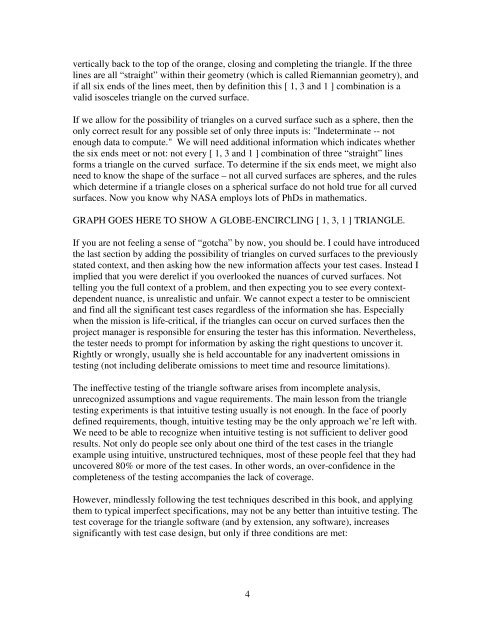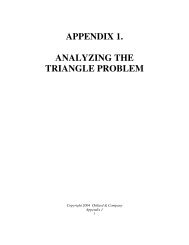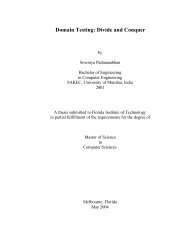Exercise: Analyzing the Triangle Problem - Testing Education
Exercise: Analyzing the Triangle Problem - Testing Education
Exercise: Analyzing the Triangle Problem - Testing Education
Create successful ePaper yourself
Turn your PDF publications into a flip-book with our unique Google optimized e-Paper software.
vertically back to <strong>the</strong> top of <strong>the</strong> orange, closing and completing <strong>the</strong> triangle. If <strong>the</strong> three<br />
lines are all “straight” within <strong>the</strong>ir geometry (which is called Riemannian geometry), and<br />
if all six ends of <strong>the</strong> lines meet, <strong>the</strong>n by definition this [ 1, 3 and 1 ] combination is a<br />
valid isosceles triangle on <strong>the</strong> curved surface.<br />
If we allow for <strong>the</strong> possibility of triangles on a curved surface such as a sphere, <strong>the</strong>n <strong>the</strong><br />
only correct result for any possible set of only three inputs is: "Indeterminate -- not<br />
enough data to compute." We will need additional information which indicates whe<strong>the</strong>r<br />
<strong>the</strong> six ends meet or not: not every [ 1, 3 and 1 ] combination of three “straight” lines<br />
forms a triangle on <strong>the</strong> curved surface. To determine if <strong>the</strong> six ends meet, we might also<br />
need to know <strong>the</strong> shape of <strong>the</strong> surface – not all curved surfaces are spheres, and <strong>the</strong> rules<br />
which determine if a triangle closes on a spherical surface do not hold true for all curved<br />
surfaces. Now you know why NASA employs lots of PhDs in ma<strong>the</strong>matics.<br />
GRAPH GOES HERE TO SHOW A GLOBE-ENCIRCLING [ 1, 3, 1 ] TRIANGLE.<br />
If you are not feeling a sense of “gotcha” by now, you should be. I could have introduced<br />
<strong>the</strong> last section by adding <strong>the</strong> possibility of triangles on curved surfaces to <strong>the</strong> previously<br />
stated context, and <strong>the</strong>n asking how <strong>the</strong> new information affects your test cases. Instead I<br />
implied that you were derelict if you overlooked <strong>the</strong> nuances of curved surfaces. Not<br />
telling you <strong>the</strong> full context of a problem, and <strong>the</strong>n expecting you to see every contextdependent<br />
nuance, is unrealistic and unfair. We cannot expect a tester to be omniscient<br />
and find all <strong>the</strong> significant test cases regardless of <strong>the</strong> information she has. Especially<br />
when <strong>the</strong> mission is life-critical, if <strong>the</strong> triangles can occur on curved surfaces <strong>the</strong>n <strong>the</strong><br />
project manager is responsible for ensuring <strong>the</strong> tester has this information. Never<strong>the</strong>less,<br />
<strong>the</strong> tester needs to prompt for information by asking <strong>the</strong> right questions to uncover it.<br />
Rightly or wrongly, usually she is held accountable for any inadvertent omissions in<br />
testing (not including deliberate omissions to meet time and resource limitations).<br />
The ineffective testing of <strong>the</strong> triangle software arises from incomplete analysis,<br />
unrecognized assumptions and vague requirements. The main lesson from <strong>the</strong> triangle<br />
testing experiments is that intuitive testing usually is not enough. In <strong>the</strong> face of poorly<br />
defined requirements, though, intuitive testing may be <strong>the</strong> only approach we’re left with.<br />
We need to be able to recognize when intuitive testing is not sufficient to deliver good<br />
results. Not only do people see only about one third of <strong>the</strong> test cases in <strong>the</strong> triangle<br />
example using intuitive, unstructured techniques, most of <strong>the</strong>se people feel that <strong>the</strong>y had<br />
uncovered 80% or more of <strong>the</strong> test cases. In o<strong>the</strong>r words, an over-confidence in <strong>the</strong><br />
completeness of <strong>the</strong> testing accompanies <strong>the</strong> lack of coverage.<br />
However, mindlessly following <strong>the</strong> test techniques described in this book, and applying<br />
<strong>the</strong>m to typical imperfect specifications, may not be any better than intuitive testing. The<br />
test coverage for <strong>the</strong> triangle software (and by extension, any software), increases<br />
significantly with test case design, but only if three conditions are met:<br />
4








